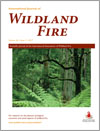
International Journal of Wildland Fire
Volume 26 Number 3 2017
WF16118Variability and drivers of extreme fire weather in fire-prone areas of south-eastern Australia
We identify the most extreme fire weather days based on McArthur’s Forest Fire Danger Index (FFDI) for 24 sites across south-eastern Australia for potential use in fire risk planning. The extent and variability of these highest FFDI days are analysed by the contributions of temperature, relative humidity, wind speed, wind direction and drought indices.
WF16106Hillslope-scale prediction of terrain and forest canopy effects on temperature and near-surface soil moisture deficit
Fire managers often use a drought index at coarse spatial resolution to determine soil moisture status in flammable forests. In complex terrain, there is a fine-scale mosaic of near-surface soil moisture deficit that may create important constraints on prescribed burning operations. A simple method is proposed for predicting this pattern.
WF16026Spatial distribution of grassland fires at the regional scale based on the MODIS active fire products
This study used kernel density estimation to analyse the spatial pattern of grassland fires based on the MODIS active fire product and to define grassland fire risk zones. The results show that the kernel density estimation method can be applied to analyse the spatial distribution of grassland fires.
WF16108Spatially varying constraints of human-caused fire occurrence in British Columbia, Canada
The relative importance of different drivers of human-caused fire can vary based on levels of human footprint and biophysical characteristics of a study region. We show that human-caused fire occurrence in areas with substantial human footprint are controlled by a different set of variables than in remote areas.
WF16108 Abstract | WF16108 Full Text | WF16108PDF (702 KB) | WF16108Supplementary Material (218 KB) Open Access Article
WF16122Evaluation of the spectral characteristics of five hyperspectral and multispectral sensors for soil organic carbon estimation in burned areas
The spectral characteristics of five hyperspectral and multispectral sensors were evaluated for topsoil organic carbon prediction in burned areas. The spectral resolution of both sensors was suitable for prediction. The most relevant spectral regions for topsoil carbon estimation were the visible and short-wave infrared.
WF16195Forest fire danger, life satisfaction and feelings of safety: evidence from Australia
Forest fire danger is negatively associated with an individual’s life satisfaction and with an individual’s feelings of safety. Feelings of safety largely explain the association between forest fire danger and life satisfaction. We find that individuals are willing-to-pay $10 to avoid a one unit increase in forest fire danger.
Professor Coutinho (1934–2016; Sao Paulo, Brazil) studied fire adaptations in Brazilian savannas during the 1970s, when very few researchers recognised fire as an evolutionary force. His main contributions were on fire-stimulated flowering, serotiny and nutrient cycling. However, he is little known, partly because he was not Anglo-Saxon but also because he was ahead of his time, when fire and evolution were still distant concepts.



